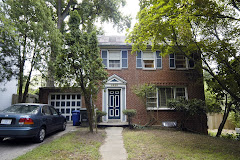''Let it forever be remembered that here -- on this spot -- men and women stood proud, they stood fast, so that we may be who we are, we may work where we will, live where we choose and love whom our hearts desire.''Nine and a half years later, not one more queer site has been seen fit for the National Historic Landmarks list. And, not a single queer site has made it on the National Register, the next level down from 'landmark' status. The work that Carter, Dolkart, Harris and Shockly put into getting the Stonewall nomination accepted has turned into a once-and-only event.
The Stonewall Inn certainly deserves its place as a queer national historic site but how could it be the only one. Two years after landmark status was achieved the Keeper of the National Register Carol Shull and Beth Savage, architectural historian at the National Register, congratulated themselves and the National Park Service in a paper at the annual NCSHPO meeting in DC:
"Historic places associated with other groups in American society forced to fight for civil rights are beginning to be documented, and more will be identified as part of the NPS’s civil rights study. Stonewall in Greenwich Village, the site of the 1969 raid and demonstrations regarded by many as the single-most important event that led to the modern gay and lesbian liberation movement, was documented by several local organizations and nominated to the National Register by the New York State Historic Preservation Officer. After its listing, Stonewall was designated a NHL for the exceptional role it has played in the Nation’s history."Yet that same year, the National Park Service dropped entirely the discussion of queer historic sites from its year long study Civil Rights in America: A Framework for Identifying Significant Sites.
So now nearly forty years after the Stonewall riots, at the thirtieth anniversary of the Milk assassination, and four weeks after Proposition 8 triumphed in California, queer historic sites linger in preservation limbo. We certainly have historic sites -- and not just bars and clubs -- to remind us of our historic struggles. We need to get them out of the preservation closet and into the main streets of preservation.
The nomination to the National Park Service: by David Carter, Andrew Dolkart, Gale Harris, Jay Shockly - http://www.nps.gov/nhl/designations/samples/ny/stone.pdf
New York Times' coverage of the National Historic Landmark listing:
http://query.nytimes.com/gst/fullpage.html?res=9A03E7D7123AF935A15755C0A96F958260




3 comments:
This site will make a great contribution to recognizing gay history. Keep it up. How are similar sites recognized in other countries?
Received David Carter (author Stonewall, 2004):
From David Carter, author of Stonewall(2004) the following comment on the Stonewall Inn nomination:
"I was approached by the Greenwich Village Society for Historic Preservation about writing a proposal for getting the Stonewall listed on the National Register of Historic Places as they knew I was writing a book on Stonewall and the 30th anniversary of the riots was approaching. They said that nothing would be considered before at least 30 years since an event had taken place. I met with some preservationists who had worked on a prior submission. They talked about the original establishment and I pointed out that my research showed that just as important if not more so than the actual building was the geography of the immediate vicinity: a large enough space for people to gather in (rare in Manhattan), a transportation nexus, and the crazy quilt pattern of the streets. They therefore proposed that we list both the building and the area around it. I backed that and collated my research and gave it to the preservationists, who knew how to package it both per the formalities of such a nomination as well as how to describe the architectural features. The nomination was extremely well received, and after passing the state level it went on to get listed on the National Register of Historic Places. A decision was made to also apply for the designation of National Historic Landmark and to do it soon, as a Democratic administration was in office. The same nomination was submitted and the Stonewall Historic District, created in 1999, was recognized as a National Historic Landmark, the highest such recognition given by the federal government, placing the Stonewall Riots site in the exclusive club with such members as Independence Hall and the Statue of Liberty and Mount Vernon in 2000. This was the first time a site was listed in either category because of LGBT historical significance."
I think with all of the attention that Harvey Milk is receiving, it might be worth trying to get his camera shop on the National Register, if it is still there. And that possibly could be the main portion of a broader Castro historic district.
Post a Comment